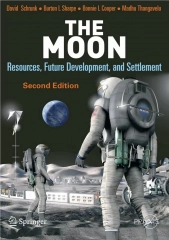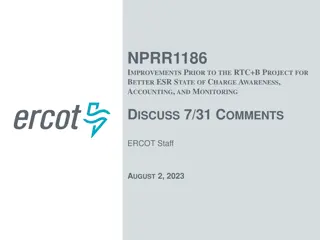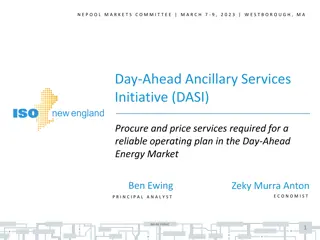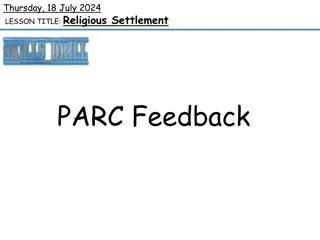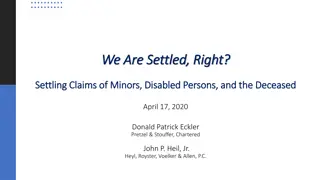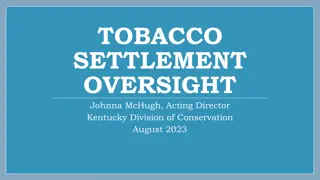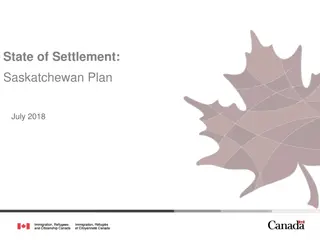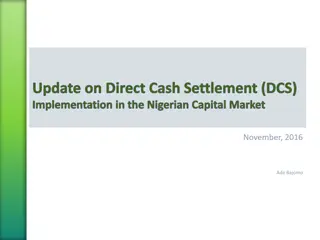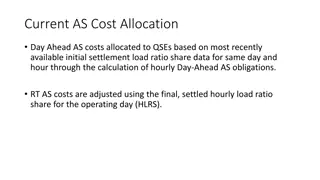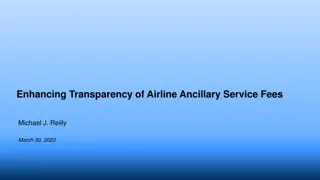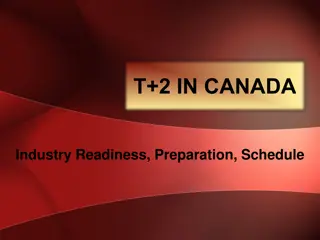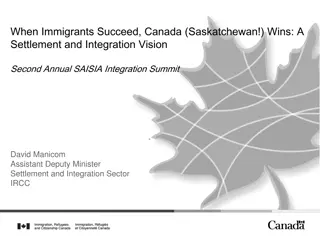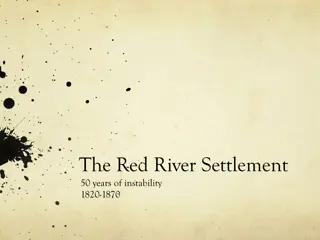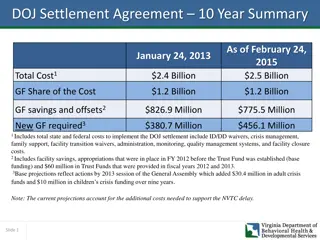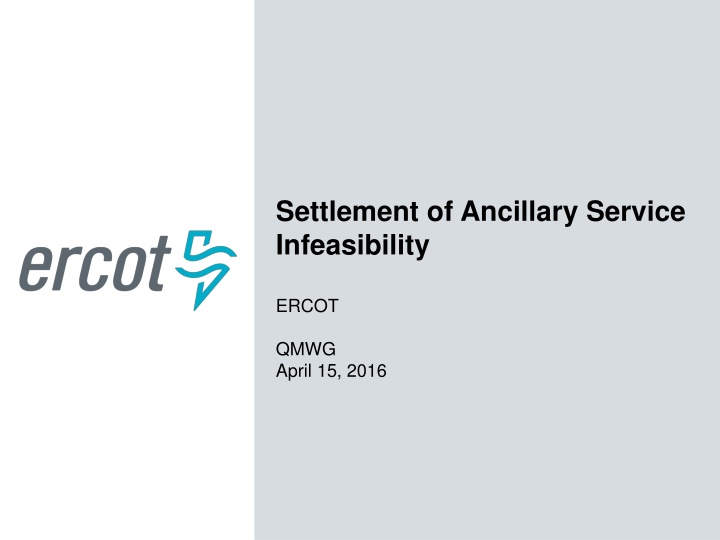
ERCOT Ancillary Service Settlement Principles Discussion
"Learn about ERCOT's treatment for infeasible ancillary services, including charging DAM prices, replacement cost allocation, and revenue distribution. Explore scenarios and operational practices discussed in ERCOT meetings. Understand the unique considerations for Non-Spin capacity. Stay informed on ERCOT protocols and practices." (287 characters)
Download Presentation

Please find below an Image/Link to download the presentation.
The content on the website is provided AS IS for your information and personal use only. It may not be sold, licensed, or shared on other websites without obtaining consent from the author. If you encounter any issues during the download, it is possible that the publisher has removed the file from their server.
You are allowed to download the files provided on this website for personal or commercial use, subject to the condition that they are used lawfully. All files are the property of their respective owners.
The content on the website is provided AS IS for your information and personal use only. It may not be sold, licensed, or shared on other websites without obtaining consent from the author.
E N D
Presentation Transcript
Settlement of Ancillary Service Infeasibility ERCOT QMWG April 15, 2016
Settlement Treatment for Replacement of Infeasible Ancillary Services General Settlement Principles for discussion with QMWG: 1. The QSE with the infeasible AS will be charged the DAM clearing price regardless whether the responsibility was awarded, self-arranged, or traded, and regardless of whether a SASM is executed. 2. The replacement cost, if any, is charged to all QSEs based on LRS. 3. The QSE with the AS infeasible is not directly charged the full replacement cost, if any. 4. All revenues collected from charges to QSEs due to infeasible AS are paid to all QSEs based on LRS. PUBLIC
Settlement Treatment for Replacement of Infeasible Ancillary Services Definition of Ancillary Service being Undeliverable The terms undeliverable and infeasible are used interchangeably in the Protocols ERCOT believes the term undeliverable is misleading and will provide additional clarity in the NPRR. 3 PUBLIC
Questions Raised at March 2016 QMWG Meeting ERCOT was asked to provide samples of Resource AS Responsibility being infeasible 3 distinct scenarios have been discussed 1. Reserved Resource capacity needed to solve transmission congestion a. Resource deployment needs to be between HSL and HASL or LASL and LSL to solve the congestion b. May be detected in HRUC or in real-time c. Common reason for AS being deemed infeasible 2. Reserved Resource capacity needed to match expected supply and demand a. Resource deployment needs to be between HSL and HASL or LASL and LSL to solve the congestion b. Detected in HRUC c. Expectation that AS would not be deemed infeasible and that AS would be deployed in real-time as needed 3. Physical deployment of AS would negatively effect transmission congestion a. For example, Reg. Up deployments on a Resource with a hurting shift factor on a constraint results in overloads that cannot be managed by SCED b. This is not captured in HRUC and would be rare for deeming as infeasible c. Likely needs Protocol clarification 4 PUBLIC
Questions Raised at March 2016 QMWG Meeting ERCOT was asked to provide samples of Resource AS Responsibility being infeasible Non-Spin is unique from other AS regarding infeasibility Unlike other AS, Non-Spin can be deployed for solving local transmission congestion Current operational practice is to not deem Non-Spin capacity infeasible when it is needed for transmission congestion and to deploy the Non- Spin on that specific Resource, as necessary Not intending to change this practice 5 PUBLIC
Questions Raised at March 2016 QMWG Meeting ERCOT was asked to provide a sample of an AS Responsibility declared infeasible due to transmission constraints for Regulation Down 210 Example: Resource with a 50% hurting shift factor on the constraint SCED constraint flow is 4 MW greater than the limit Resource must be dispatched down 8 additional MW to resolve the constraint (from 110 to 102) 190 Reg. Down Relocated and Constraint Fully Resolved by SCED No Constraint Resolution Limited by LASL Constraint 170 MW 150 130 110 90 8:00 8:05 8:10 8:15 8:20 8:25 8:30 8:35 8:40 8:45 Time Stamp HSL LSL LASL BP 6 PUBLIC
Questions Raised at March 2016 QMWG Meeting ERCOT was asked to explain the impact of AS infeasibility on AS Imbalance RTOLCAPq Online Capacity already reserved RTASOLIMBq = Online Capacity in Real-Time: RTASOLIMB RTASOLIMB Real Time Ancillary Service On-Line Reserve Imbalance Real-Time On-Line Reserve Capacity RTOLCAP Reserved 7 PUBLIC
Questions Raised at March 2016 QMWG Meeting ERCOT was asked to explain the impact of AS infeasibility on AS Imbalance RTOLCAPq Online Capacity already reserved RTASOLIMBq = Online Capacity in Real-Time: RTASOLIMB RTASOLIMB Real Time Ancillary Service On-Line Reserve Imbalance Real-Time On-Line Reserve Capacity RTOLCAP (Reserved AS Undeliverable) 8 PUBLIC
Ancillary Service On-Line Reserve Imbalance The Real-Time Ancillary Service Supply Responsibility will be reduced by the MW of infeasible AS, which will increase the Real Time Ancillary Service On-Line Reserve Imbalance volume used in the calculation of the Real-Time Ancillary Service Imbalance Amount payment. RTASIAMTq = (-1)* [(RTASOLIMB q * RTRSVPOR) + (RTASOFFIMB q * TRSVPOFF)] RTASOLIMBq = RTOLCAPq [(RTASRESPq * ) RTASOFFq RTRUCNBBRESPq RTCLRNSRESPq RTRMRRESPq] Real-Time Ancillary Service Supply Responsibility RTASRESP RTASOFF Real-Time Ancillary Service Schedule for the Off-Line Generation Resource RTRUCNBBRESP Real-Time RUC Ancillary Service Supply Responsibility in Non-Buy-Back hours RTCLRNSRESP Real-Time Controllable Load Resource Non-Spin Responsibility RTRMRRESP Real-Time Ancillary Service Supply Responsibility for RMR Units 9 PUBLIC
Questions Raised at March 2016 QMWG Meeting ERCOT was asked to explain impact of an AS Responsibility declared infeasible due to transmission constraints on DAM Make Whole Payments Day-Ahead Make-Whole Payment ( ) ( ) < DAM Revenues DAM Guaranteed Amount A QSE will receive a Make-Whole Payment if its revenues from the DAM are less than the Startup, Minimum Energy, and Operating costs 10 PUBLIC
Day-Ahead Make-Whole Payment What if revenues are less than costs? Difference = Make-Whole Payment $ Incremental Energy Costs Minimum Energy Costs Make-Whole Payment Day-Ahead Market Sales Start-up Costs Costs Incurred Revenues Received 11 PUBLIC
Day-Ahead Make-Whole Payment What if revenues are greater than costs? Day-Ahead Market Sales = DAM Energy Sales * SPP + AS Sales * MCPC No Make-Whole Payment $ Incremental Energy Costs Minimum Energy Costs Day-Ahead Market Sales Start-up Costs Costs Incurred Revenues Received 12 PUBLIC
Day-Ahead Make-Whole Payment Energy Sales * SPP + AS Sales * MCPC Energy Sales * SPP $ No Make-Whole Payment Make-Whole Payment Day-Ahead Market Sales Day-Ahead Market Sales With AS Sales Without AS Sales PUBLIC
Day-Ahead Make-Whole Payment Should DAM AS Revenues be removed from Make Whole Payments if these are clawed back due to an AS Infeasible event? a) b) Creates a dependency whenever ERCOT settles DAM (Requires Resettlement) Historically few instances of AS Infeasibility. May not justify changing DAM Make whole settlement equations Creates System impact to modify settlement equations c) PUBLIC
Settlement Treatment for Replacement of Infeasible Ancillary Services General Settlement Principles for discussion with QMWG: 1. The QSE with the infeasible AS will be charged the DAM clearing price regardless whether the responsibility was awarded, self-arranged, or traded, and regardless of whether a SASM is executed. 2. The replacement cost, if any, is charged to all QSEs based on LRS. 3. The QSE with the AS infeasible is not directly charged the full replacement cost, if any. 4. All revenues collected from charges to QSEs due to infeasible AS are paid to all QSEs based on LRS. PUBLIC
Appendix 16 ERCOT Public PUBLIC
Ancillary Services Replacement Presenter: Ino Gonz lez QMWG July 10, 2015 17 ERCOT Public PUBLIC
Replacement of Undeliverable Ancillary Services Replacement of Undeliverable Ancillary Service Due to Transmission Constraints NP 6.4.9.1.2 (4) If ERCOT procures additional Ancillary Services for the amount of substituted capacity that is deemed infeasible or the amount of Ancillary Services capacity that each affected QSE does not replace, then all QSEs that bought the specific Ancillary Service in the DAM are charged for their share of the net cost incurred for the Ancillary Service procured by ERCOT as part of the multiple procurement processes (DAM and SASMs) , in accordance with Section 6.7.3, Adjustments to Cost Allocations for Ancillary Services Procurement. 18 ERCOT Public PUBLIC
Replacement of Undeliverable Ancillary Services Replacement of Undeliverable Ancillary Service Due to Transmission Constraints NP 6.4.9.1.2 (5) If the QSE s Ancillary Service capacity that is undeliverable because of a transmission constraint identified by ERCOT, as set forth in (1) above, was not awarded in the DAM or any SASM (i.e., the capacity is part of Self-Arranged Ancillary Services for the hours of the RUC Study Period), then the QSE is charged for the insufficient Ancillary Service capacity the same price paid for the Ancillary Service as purchasers in the DAM paid for that time period, as determined under paragraph (4) above. 19 ERCOT Public PUBLIC
Replacement of Undeliverable Ancillary Services Replacement of Undeliverable Ancillary Service Due to Transmission Constraints NP 6.4.9.1.2 (6) If the QSE s Ancillary Service capacity that is undeliverable because of a transmission constraint identified by ERCOT, as set forth in (1) above, was awarded in the DAM or any SASM, then the QSE is not compensated for the quantity of the Ancillary Service capacity that is undeliverable. 20 ERCOT Public PUBLIC
Replacement of Undeliverable Ancillary Services Adjustments to Cost Allocations for Ancillary Procurement NP 6.7.3 (b) Each QSE s share of the net total costs for Reg-Up for the Operating Hour is calculated as follows: RUPR * RUQ q + Payment COLLECTED*HLRSq RUCOST q = Where: RUPR RUQTOT = RUQ q RUO q = RUCOSTTOT / RUQTOT RUQ q RUO q SARUQ q +sasm Sum[SARUQ q + (RTPCRU q, m)+ PCRU q RURP q RUFQq] * HLRSq+ RURP q = = SARUQ q = DASARUQ q+ RTSARUQ q 21 ERCOT Public PUBLIC
Questions that need to be answered to develop an NPRR 1. Should QSEs be charged (claw back) for undeliverable MWs? Options: Based on replaced MW or Undeliverable MW quantities Note: Replaced MWs Undeliverable MWs Example: DAM Award (10MW), Undeliverable (7MW), RURP(5MW), MCPCRU ($3) DAM Payment = (-1)*10MW*$3/MWh = ($30) Claw back option 1= 7MW*$3/MWh = $21 (QMWG consensus) Claw back option 2 = 5MW**$3/MWh = $15 2. To what extend QSEs with self-arrange MWs are responsible for undeliverable quantities? Should QSEs with DAM Obligations be charged when the self-arranged MWs are part of a trade that is undeliverable? (Yes, QMWG consensus) Other policy questions? 3. 22 ERCOT Public PUBLIC


